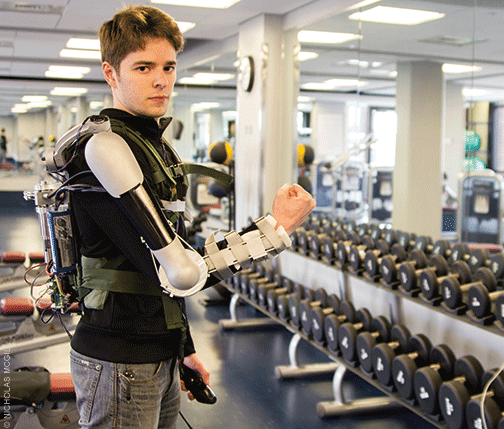
Nikolay Vladimirov
On the east side of campus, tucked away in the Towne Building, lies the PACE Laboratory, a mechanical engineering research space. Various contraptions line the room, and hanging on one of the walls is an oversized check for $10,000. Scattered about the floor are several copies of Philadelphia’s Metro newspaper featuring a cover story about a “revolutionary device,” which sits only a few feet away.
For the past couple of years, four Penn student engineers—Nick Parrotta, Elizabeth Beattie, Nick McGill, and Nikolay Vladimirov—have worked diligently to build the “Titan Arm” for their senior project in mechanical engineering and applied mechanics. Weighing about 18 pounds, this bionic exoskeleton attaches onto the user’s arm with a backpack motor for power. Strap it on and your right arm can instantly lift an additional 40 pounds.
The idea of a bionic bicep didn’t come easily. The team had initially considered designing a prosthetic hand. Deeming this to be impractical for a senior project, they settled on creating an upper-body exoskeleton and presented the idea to senior lecturer Jonathan Fiene, their advisor. Fiene cautioned them about the difficulty of their proposal, but nonetheless gave it a green light.
When the team unveiled the prototype last spring—manufactured with the help of 3D printing—it quickly garnered buzz in the tech world. In May, the Titan Arm won $10,000 for first place in the Cornell Cup, a college-level mechanical engineering contest. Then the four Penn students became the first American team to ever receive the James Dyson Award, for which they pocketed another $45,000, with an additional $15,000 going to Penn Engineering. Dyson, known primarily as the inventor of the bagless vacuum cleaner, organizes the engineering contest, which is open only to college students and recent graduates.
Along with the prizes, the Titan Arm has attracted international publicity from numerous media outlets, including the BBC, Wired, and CNN. The team describes this attention as “fantastic,” if perhaps a little overheated.
“The media teams sometimes want to transform the project from being an augmented lifting device to the next Iron Man suit, when in reality, our team is more passionate about helping patients get back to a normal, everyday life,” McGill says.
The bionic exoskeleton, for instance, could potentially help patients with back or arm injuries regain control of their muscles in conjunction with physical therapy. The robotic arm also has the capacity to collect data on the user’s range of motion, which could help doctors track a patient’s recovery. McGill says the arm also could be used for occupational lifting by UPS employees and warehouse workers.
The team estimates that their production cost came in at about $2,000—1/50th the price of current exoskeletons on the market. Because of their high costs, insurance companies rarely cover robotic exoskeletons.
The four engineers have been particularly heartened by several emails from individuals suffering from injuries that they believe the Titan Arm could ameliorate.
“The idea that what we’re doing has created enough hope in someone that they want to reach out to us and offer to be an alpha or beta tester for the early prototypes, that’s so inspiring and motivating,” Parrotta says.
In the meantime, the engineers plan on using the prize money to continue working on the project. Right now, the user directly controls the arm with a joystick, but they’re trying to find a way to allow the arm to move without one. Likewise, they hope to eventually create an exoskeleton device for both arms.u
—Matt Fernandez C’14




